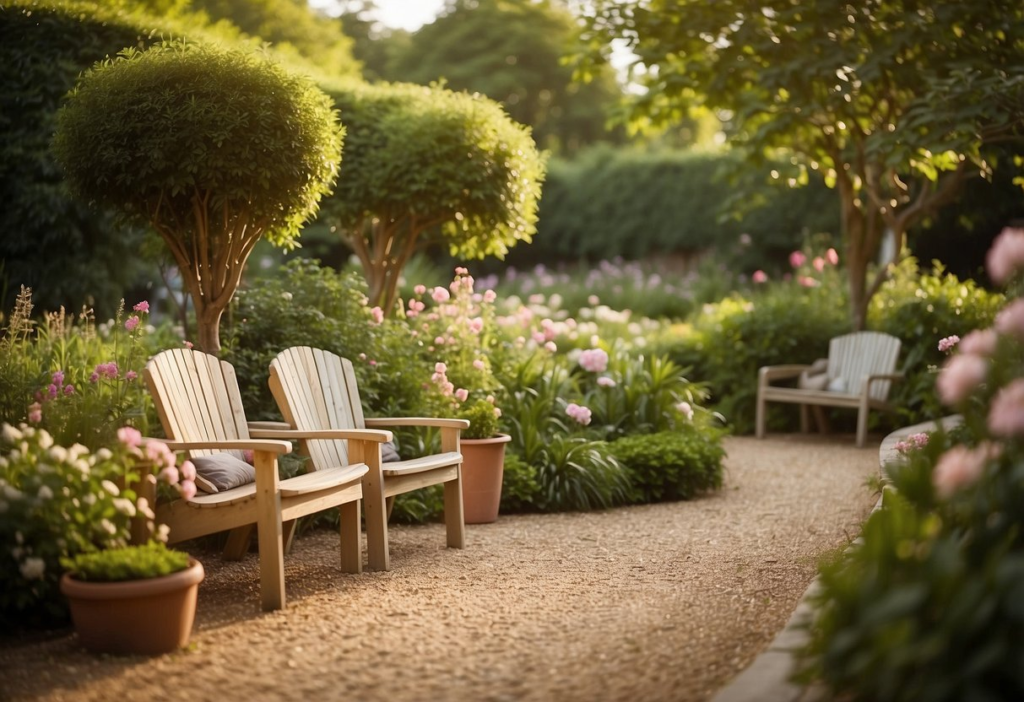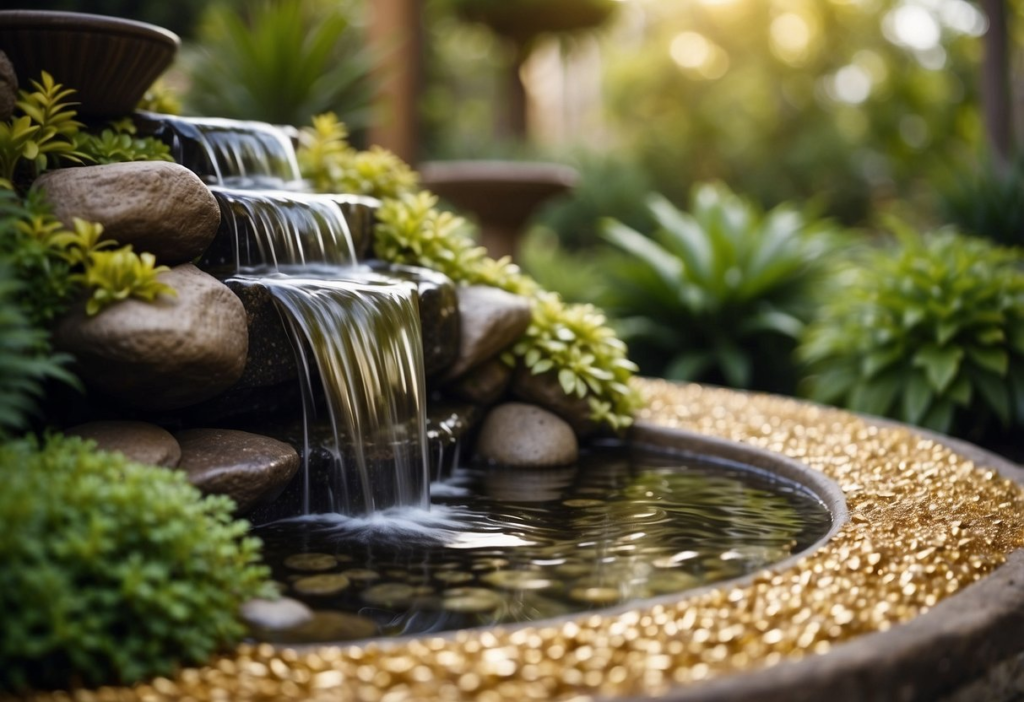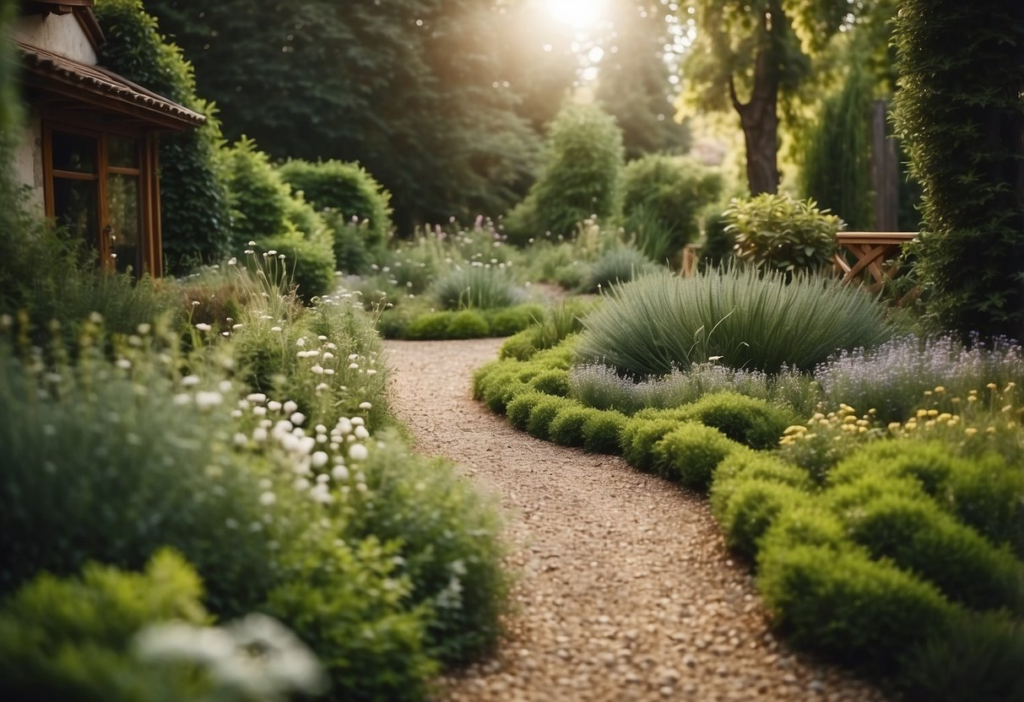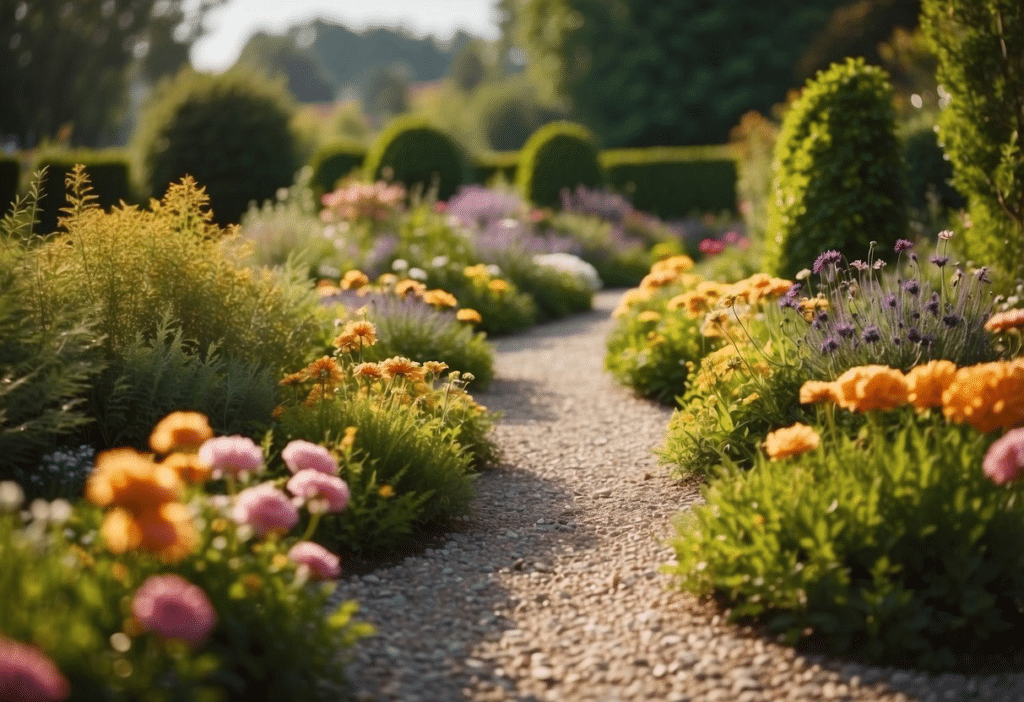
Golden gravel gardens enhance your outdoor area’s aesthetics and usefulness. Golden-colored gravel is used in these gardens to produce a light and airy aesthetic. For anyone looking for a chic and low-maintenance landscape, they are ideal.
It doesn’t take much labor to have a gorgeous garden all year long. In addition to giving your garden a pleasant hue, golden gravel promotes better drainage and weed control. This kind of garden is popular with both homeowners and garden enthusiasts since it can change any yard.
Golden Gravel Pathways

Golden gravel pathways are a stunning addition to any garden, infusing a touch of warmth and brightness into the space. The rich, golden hues of the gravel contrast beautifully with the vibrant colors of your plants.
Installing golden gravel is straightforward, providing a durable and visually appealing route through your garden. This option not only enhances the aesthetic but also requires minimal maintenance, ensuring that your pathways remain attractive for years to come.
Consider adding stepping stones to your golden gravel paths. They offer practical benefits by creating defined walkways and protecting your plants from trampling, all while adding an extra layer of charm to your garden.
Japanese Zen Gravel Garden

Transform your garden into a tranquil retreat with a Japanese Zen gravel garden. This style emphasizes simplicity and tranquility, featuring elements like carefully arranged rocks, gravel, and minimalistic plants to create a serene environment.
Raking patterns into the gravel to represent water ripples or flowing streams can enhance the meditative quality of your space. These designs promote relaxation and provide a peaceful spot for reflection.
Incorporating a small water feature, such as a fountain surrounded by pebbles, can further enhance the serene atmosphere. For added visual appeal, consider placing large rocks within the gravel to create a balanced and harmonious design.
Golden Gravel Borders

Golden gravel borders are an elegant way to frame your garden. Their vibrant color creates a striking contrast against the greenery of your plants, adding a touch of sophistication to your garden design.
To achieve a neat appearance, start by laying down a weed barrier before spreading the gravel. This helps to maintain the integrity of your borders and prevents unwanted plant growth. Golden gravel is also an effective tool for demarcating different areas in your garden, such as paths, flower beds, and seating spaces, making your garden both functional and aesthetically pleasing.
Succulent and Gravel Display

A succulent and gravel display offers a visually stunning and low-maintenance garden solution. Choose a variety of colorful succulents like Echeveria, Graptoveria, and Sedum to add vibrant touches to your garden.
Cover the base with golden gravel, which not only provides excellent drainage but also creates a beautiful contrast with the succulents. Enhance your display with decorative stones or small statues to add unique and personal touches.
Golden Gravel Seating Area

Creating a golden gravel seating area introduces warmth and elegance to your outdoor space. Select a sunny spot to showcase the golden hues of the gravel, and begin by clearing the area of weeds and laying down a weed barrier.
Spread the gravel evenly and place comfortable chairs and a small table on top. Add a few potted plants to complete the setup. This setup offers a cozy and inviting area where you can relax and enjoy your garden.
Gravel and Stone Accents

Incorporating gravel and stone accents can elevate the beauty and functionality of your garden. Combine golden gravel with larger stones to create visual contrast and texture.
Place stepping stones throughout the garden to form clear paths and protect your plants. Opt for pea gravel in areas frequented by children or pets for a softer surface. Arrange stones to create defined seating areas or borders around flower beds, adding a natural, rustic charm to your garden.
Mediterranean Gravel Garden

A Mediterranean gravel garden offers a stylish and low-maintenance garden option. Warm-toned gravel, such as golden gravel, complements the sunny, dry climate typical of Mediterranean-style gardens.
Incorporate terracotta pots filled with drought-tolerant plants like lavender or rosemary to add color and fragrance. Consider adding natural stone elements, such as a dry stone terrace, to break up the gravel and create cozy seating areas. Stone paths can also guide visitors through the garden and highlight key plants.
Golden Gravel Water Feature

Enhancing your golden gravel garden with a water feature can create a soothing and inviting atmosphere. Use golden gravel around the base of a fountain or pond to complement the water’s beauty.
The golden tones of the gravel will contrast elegantly with the water, adding to the feature’s appeal. Ensure the ground is level before laying the gravel to prevent shifting and maintain a clean appearance.
Herb Garden with Gravel Paths

Designing an herb garden with winding gravel paths combines practicality with charm. Gravel paths help define the garden space and keep your shoes clean.
Select herbs like rosemary, thyme, and basil, which thrive in sunny conditions and offer a range of culinary flavors. Ensure the paths are wide enough for easy access between plants.
Gravel helps control weeds and improves drainage, making it a low-maintenance choice for busy gardeners.
Golden Gravel Rockery

Creating a golden gravel rockery involves choosing rocks and gravel in complementary warm hues. Pair the golden gravel with colorful flowers and plants that flourish in well-drained soil.
The golden gravel adds a warm glow, contrasting beautifully with green foliage and vibrant blooms. Use various sizes of gravel and boulders to introduce texture and visual interest to your rockery.
Benefits Of A Golden Gravel Garden

Golden gravel gardens offer numerous advantages, including ease of maintenance, aesthetic appeal, and environmental benefits.
Low Maintenance
Maintaining a golden gravel garden is straightforward. The gravel naturally suppresses weed growth, so you won’t spend much time weeding. It also prevents soil erosion and reduces the need for frequent watering by retaining soil moisture longer.
Unlike organic mulches, golden gravel does not decompose, so you won’t need to replace it as often. Its structure provides excellent drainage, preventing water from pooling and reducing the risk of root rot. This makes it a great choice for gardens in areas with heavy rainfall or waterlogged conditions.
Aesthetically Pleasing
Golden gravel brings a warm, natural glow to any outdoor area. It can elevate the appearance of garden paths, borders, and driveways, turning them into elegant features. The golden hues of the gravel contrast beautifully with green plants, making your garden look vibrant and inviting.
You can use golden gravel to define clean lines around flower beds or separate different sections of your garden. This creates a neat and organized appearance. Additionally, the crunching sound of gravel underfoot adds to the sensory experience of your garden.
Eco-Friendly
Golden gravel is an environmentally friendly option for landscaping. As a natural material, it does not introduce harmful chemicals into the soil, unlike some synthetic mulches. Using gravel also reduces the need for frequent watering, which is beneficial in drought-prone areas.
Gravel gardens lower your carbon footprint by reducing the need for lawn maintenance equipment that runs on fossil fuels. Moreover, gravel improves ground permeability, allowing rainwater to soak into the soil and replenish groundwater supplies.
Design Tips For Golden Gravel Gardens

To make the most of your golden gravel garden, choose the right plants and consider incorporating water features to add texture and variety.
Choosing The Right Plants
Select plants that thrive in sunny, dry conditions to complement your golden gravel garden. Drought-tolerant options like lavender, rosemary, and sedum are ideal, as they can withstand dry spells and add vibrant colors and fragrances.
For added visual interest, incorporate contrasting foliage plants such as blue fescue or silver-leafed artemisia. Succulents like aeoniums and stonecrop are also excellent choices, as they require minimal water and have striking forms. Grouping these plants can enhance their visual impact.
Incorporating Water Features
Adding a water feature can enhance the tranquility of your golden gravel garden. Small fountains or bubbling rocks are great options for their soothing water sounds and low maintenance. They can serve as focal points and contribute to a relaxing atmosphere.
Birdbaths can attract wildlife and bring additional life to your garden. Choose natural stone or simple designs that blend with the golden gravel. For a more dramatic effect, consider installing a pond lined with rocks and filled with aquatic plants, creating a balanced ecosystem that complements your dry garden.
Maintenance Guidelines
Maintaining a golden gravel garden involves regular care to keep it looking pristine. This includes managing weeds and keeping the gravel evenly distributed.
Weed Control
Effective weed management is crucial for a tidy gravel garden. Start by laying a weed membrane beneath the gravel, which helps prevent weed growth. Even with a membrane, some weeds may emerge. Remove them promptly to prevent spreading. Hand-pulling is effective for small areas, while a weed killer designed for gravel can be useful for larger spaces.
Adding a fresh layer of gravel annually can smother new weed seeds and maintain a clean appearance. Regular inspections and quick removal of weeds will keep your garden looking its best.
Regular Raking
Raking helps maintain an even surface in your gravel garden. It redistributes the gravel and prevents it from becoming uneven. Use a leaf rake or a gravel rake with wider tines. Begin at one end and work your way across the garden. Raking also removes debris like leaves and twigs.
As gravel can shift over time, regular raking is necessary to keep the surface smooth and supportive of walking and plant growth. Aim to rake your garden once a week for optimal results.
